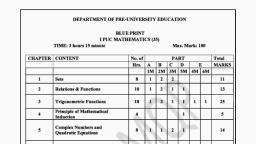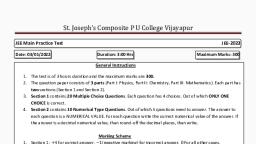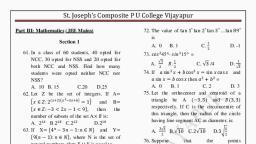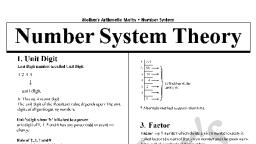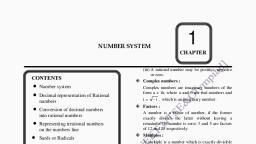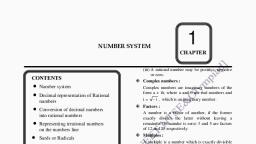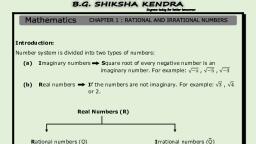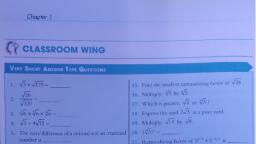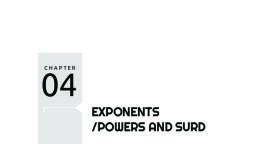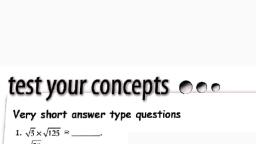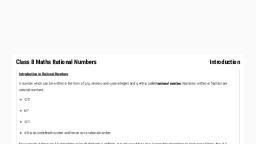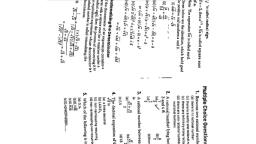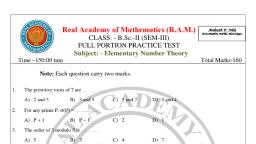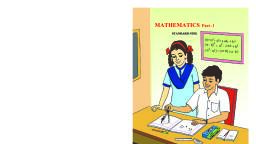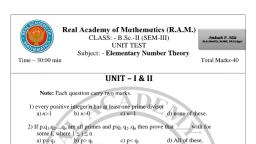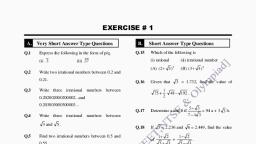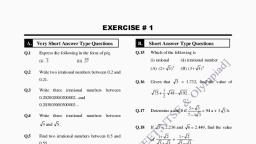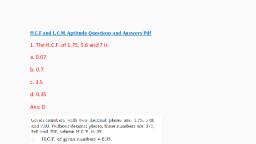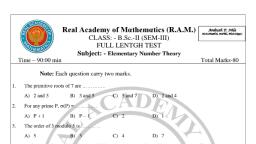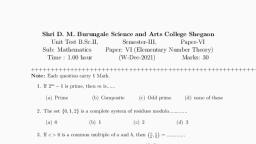Page 1 :
1., BASIC MATHEMATICS, NUMBER SYSTEM, Complex Number, (z = x + iy), Imaginary, x + 0, y + 0, Pure Imaginary, x + 0, y 0, Pure Real (R), (Real Number), X + 0, y + 0, Definition : The union of the, sets of rational numbers and, irrational numbers, Definition : Number that can be, written as a ratio of two integers, Definition : Real, number that are, not rational, The set of Rational numbers, includes all decimals that have, either a finite number of decimal, places or that repeat in the same, pattern of digits., Rational, irrational, Number (Q) Number (Q, e.g. T, V2, V3, Fractions, e.g. 3/4, 0.2, Make up : Includes integers,, whole number, Natural numbers, and these number are written, as the ratio of two integers., Integers (I or Z)He.g. -1, 0,4|, More eg. 3/5, -1/7 e.g. 1/2 and -3/1, Also known as, counting number, Positive Negative, Integer Integer, Whole, Number (W), Od, Number, Even, I,, Number, Natural, Number (N), All the integers, excluding zero, Zero is a special number, it doesn't, quite obey all the same laws as, other numbers i.e. you cannot, divide by zero, Prime, Number, Composite, Number, Figure 1.1: The number system
Page 2 :
1.2 | Basic Mathematics, 1. NUMBER SYSTEM, (a) Natural Numbers: The counting numbers 1, 2, 3, 4,, numbers is denoted by N., . are called natural numbers. The set of natural, N = {1, 2, 3, 4, ..}, N is also denoted by I' or Z', (b) Whole Numbers: Natural numbers including zero are called whole numbers. The set of whole numbers is, denoted by W., Thus W = {0, 1, 2, ..}, (c) Integers: The numbers ... -3, -2, -1, 0, 1, 2, 3 . are called integers and the set of integers is denoted by I, or Z., Thus I (or Z) = {.-3, -2, -1, 0, 1, 2, 3..}, (a) Set of negative integers is denoted by I and consists of {., -3, -2, -1}, (b) Set of non-negative integers is denoted by W., (c) Set of non-positive integers {.. -3, -2, -1, 0}, (d) Even integers: Integers which are divisible by 2 are called even integers. e.g. 0, ±2, ± 4,, (e) Odd integers: Integers which are not divisible by 2 are called odd integers. e.g. ±1, ±3, ±5, +7, (f) Prime numbers: A natural number (except unity) is said to be a prime number if it is exactly divisible by unity, and itself only. e.g. 2, 3, 5, 7, 11, 13, 17, 19, 23, 29, 31, .., (g) Composite numbers: Natural numbers which are not prime (except unity) are called composite numbers., (h) Co-prime numbers: Two natural numbers (not necessarily prime) are said to be co-prime, if their H.C.F., (Highest common factor) is one. e.g. (1, 2), (1, 3), (3, 4), (3, 10), (3, 8), (4, 9), (5, 6), (7, 8) etc. These numbers are, also called as relatively prime numbers., (i), Twin prime numbers: If the difference between two prime numbers is two, then the numbers are called twin, prime numbers. e.g. (3, 5}, {5, 7}, (11, 13}, (17, 19}, {29, 31}, (j) Rational numbers: All the numbers that can be represented in the form p/q, where p and q are integers and, 1, q + 0, are called rational numbers and their set is denoted by Q. e.g. , 2, 0, -5,, 22, 2.5, 0.3333 ... etc. Thus, p, Q =, :p,qeI and q + 0, It may be noted that every integer is a rational number since it can be written as, p/1. The decimal part of rational numbers is either terminating or recurring., (k) Irrational numbers: There are real numbers which cannot be expressed in p/q form. These numbers are, called irrational numbers and their set is denoted by Q or Q (i.e. complementary set of Q). The decimal part, of irrational numbers is neither terminating nor recurring e.g. v2,1 + V3 , n etc., (1), Real numbers: The complete set of rational and irrational numbers is the set of real numbers and is denoted, by R. Thus R = QUQC., -1. A, (m) Complex numbers: A number of, complex number is usually denoted by 'z' and a set of complex numbers is denoted by C., form a + ib is, lled a complex number, where a, beR and i = v, CONCEPTS, Zero is neither positive nor negative but zero is non-negative and non-positive., '1' is neither prime nor composite, '2' is the only even prime number, '4' is the smallest composite number
Page 3 :
Mathematics | 1.3, Two distinct prime numbers are always co-prime but the converse need not be true., Consecutive natural numbers are always co-prime numbers., e = 2.71 is called Napier's constant and t 3.14. And both are irrational., Vaibhav Gupta (JEE 2009, AIR 22), 2. RATIO AND PROPORTION, 2.1 Ratio, (a) If A and B are two quantities of the same kind, then their ratio is A : B; which may be denoted by the fraction, A, (this may be an integer or fraction), В, a, ma, na, (b) A ratio may be represented in a number of ways e.g., where m, n, . . are non-zero, %3D, mb, nb, numbers., (c) To compare two or more ratios, reduce them to their common denominator., 2.2 Proportion, a, When two ratios are equal, then the four quantities composing them are said to be proportional. If, is written as a : b = c:d or a : b :: c:d, then it, d., b, (a) 'a' and 'd' are known as extremes and 'b' and 'c' are known as means., (b) An important property of proportion; product of extremes = product of means., (c) If a: b = c: d, then b: a = d:c (invertendo), (d) If a: b = c:d, then a : c = b:d (alternando), a+b, (e) If a: b = c:d, then, C+d, (componendo), d, %3D, a -b, (f) If a: b = c : d, then, b, с - d, (dividendo), d., a+b, (g) If a: b = c : d, then, a-b, C+d, (componendo and dividendo), с - d, 3. DEFINITION OF INDICES, If 'a' is any non-zero real or imaginary number and 'm' is a positive integer, then am = a.a.a..a (m times). Here 'a', is called the base and m is the index, power, or exponent., Law of indices:, (а) а' %3D1,, (a + 0), (b) am =, (a + 0), am, (c), am+n, = am.an, where m and n are real numbers, am, where m andn are real numbers, (d) am-n =, an
Page 4 :
1.4 | Basic Mathematics, (v) (am)n = amn, (vi) ap/a = VaP, 4. SOME IMPORTANT IDENTITIES, (a) (a + b)? = a? + 2ab + b? = (a – b)? + 4ab, (b) (a - b)? = a? - 2ab + b? = (a + b)? - 4ab, (c) a? - b? = (a + b) (a - b), (d) (a + b)3 = a3 + b3 + 3ab (a + b), (e) (a - b)3 = a³ – b3 – 3ab (a - b), (f), a3 + b3 = (a + b)³ -3ab (a + b) = (a + b) (a? + b? – ab), (g) a3 - b3 = (a – b)3 + 3ab (a – b) = (a - b) (a? + b? + ab), (h) (a + b + c)? = a? + b? + c? + 2ab + 2bc + 2ca = a? + b? + c? + 2abc, b, 1, - [(a – b)? + (b – c)? + (c – a)2], 2, (i), a? + b2 + c2 - ab - bc- са 3D, (j) a3 + b3 + c³ - 3abc = (a + b + c) (a? + b? + c? – ab – bc – ca), 1, 5 (a + b + c) [(a - b)? + (b – c)² + (c - a)?], %3D, (k) а* - b4 %3D (а + b) (а - b) (а? + b?), (1), at + a? + 1 = (a? + 1)? - a? = (1 + a + a?) (1 - a + a?), 5. SURDS, Any root of an arithmetical number which cannot be completely found is called surd. E.g. 2, 5, 7 etc. are all, surds., (a) Pure Surd: A surd which consists of purely an irrational number expressed as vn where a # x" (xel) is called, a pure surd. e.g. 7, 5 etc., (b) Mixed surd: A pure surd when multiplied with a rational number becomes a mixed surd. e.g. 2 3,4 5, 2, 3 etc., A mixed surd can be written as a pure surd. e.g. 2 x 3 = 3 x 8 = 24 , 25 = 20, %3D, %3D, (c) Order of Surd: The order of a surd is indicated by the number denoting the roots i.e. V2, 5, 7 are surds, of the 4th, 3rd and 6th order respectively., (d) Simple Surd: Surds consisting of one term only are called simple surds. E.g. 2, 3, Va'bc etc. are simple, surds or Monomial surds., (e) Compound Surd: An expression consisting of two or more simple surds connected by (+) or (-) sign is called, a compound surd. E.g. 5 2 + 4 3, 3 + 2, 3- 5.
Page 5 :
Mathematics | 1.5, 6 LOGARITHM, 6.1 Introduction, (45.5), V(3.2) (6.5), It is very lengthy and time consuming to find the value of 5 0.0000165,, or finding number of, digits in 312, 28. John Napier (1550-1617 AD) invented logarithm (in 1614 AD) to solve such problems. The word, "Logarithm" was formed by two Greek words, 'logos' which means 'ratio', and 'arithmos' meaning 'number'. Henry, Briggs (1556-1630 AD) introduced common logarithm. He published logarithm in 1624 AD., In its simplest form, a logarithm answers the question, "How many of one number do we multiply to get another, number?", Illustration 1: How many 2s do we multiply to get 8?, (JEE MAIΝ), Sol: 2 x 2 x 2 = 8, So we needed to multiply 3 of the 2s to get 8. So the logarithm of 8 to the base 2, written as, log, (8) is 3., 6.1.1 How to Write it, We would write "the number of 2s you need to multiply to get 8 is 3" as, 2x2x2 = 8, log, (8) = 3, Base, So these two things are the same., The number we are multiplying is called the "base", so we would say "The logarithm of 8 with the base 2 is 3"., Or "log base 2 of 8 is 3" or "the base-2 log of 8 is 3", 6.1.2 Exponents, Exponents and Logarithms are related, let's find out how..., The exponent says the times, to use the number in a, multiplication., exponent, 23, In this example : 2 = 2 x 2 x 2 = 8, (2 is used 3 times in a multiplication, to get 8), base, Figure 1.2, So a logarithm answers a question like this:, 2' = 8, In this way, exponent., 8, %3D, log,(8) = 3, log (8) = 3, base, (a), (b), Figure 1.3
